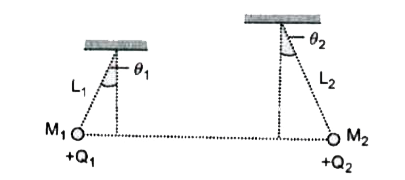Light of two different frequencies whose photons have energies 1 eV and 2.5 eV respectively, successively illuminate a metallic surface whose work function is 0.5 eV. Ratio of maximum speeds of emitted electrons will beSolution in Kannada
1:4
1:1
1:5
1:2
The correct Answer is:D
hv=w+1/2mv2max
i.e.E=w+1/2v2max
∴1/2mv2max=E−w
∴v21v22=E1−wE2−w
1eV−0.5eV2.5eV−0.5eV
=0.52=14
∴v1v2=1/2
Topper's Solved these Questions
- BOOK - MODERN PUBLICATIONCHAPTER - ELECTRONS & PHOTONSEXERCISE - MULTIPLE CHOICE QUESTIONS (LEVEL-III)9videos
ELECTRONS & PHOTONS
- BOOK - MODERN PUBLICATIONCHAPTER - ELECTROMAGNETIC WAVESEXERCISE - RECENT COMPETITIVE QUESTIONS4videos
ELECTROMAGNETIC WAVES
- BOOK - MODERN PUBLICATIONCHAPTER - ELECTROSTATICSEXERCISE - RECENT COMPETITIVE QUESTIONS39videos
ELECTROSTATICS
Similar Questions
Energy required for the electron excitation in Li++ from the first to the third Bohr orbit is :
01:38View SolutionThe speed of electromagnetic wave in vacuum depends upon the source of radiation
02:58View SolutionTwo small spheres of masses M1andM2 are suspended by weightless insulating threads of lengths L1andL2 The spheres carry charges Q1andq2 respectively . The spheres are suspended such that they are in level with one another and the threads are inclined to the vertical at angles of θ1andθ2 as shown . Which one o fthe following conditions , if θ1=θ2 ?
 02:54View Solution
02:54View SolutionLights of two different frequencies whose photons have energies 1 and 2.5 eV, respectively, successively illuminate a metal whose work function is 0.5 eV. The ratio of the maximum speeds of the emitted electrons
03:28View SolutionLight of two different frequencies whose photons have energies 1eV and 2.5 eV respectively illuminate a metallic surface whose work function is 0.5 eV successively. Ratio of maximum kinetic energy of emitted electrons will be:
03:28View SolutionLights of two different frequencies whose photons have energies 1 eV and 2.5 eV respectively illuminate successively a metal surface whose work function is 0.6 eV. The ratio of the maximum speeds of the emitted electrons will have
03:55View SolutionLight of two different frequencies whose photons have energies 1 eV and 2.5 eV respectively, successively illuminate a metallic surface whose work function is 0.5 eV. Ratio of maximum speeds of emitted electrons will be
04:49View SolutionLights of two different frequencies, whose photons have energies 1 eV and 2.5 eV respectively, successively illuminate a metal whose work function is 0.5 eV. The ratio of the maximum speeds of the emitted electrons will be
03:40View SolutionLight of two different frequencies whose photons have energies 1 eV and 2.5 eV respectively illuminate a metallic surface whose work function is 0.5 eV successively. Find the ratio of maximum speeds of emitted electrons.
02:19View SolutionLights of two different frequencies whose photons have energies 1 and 2.5 eV, respectively, successively illuminate a metal whose work function is 0.5 eV. The ratio of the maximum speeds of the emitted electrons
02:57View SolutionLights of two different frequencies whose photons have energies 1 eV and 2.5 eV respectively illuminate successively a metal surface whose work function is 0.7 eV. The ratio of the maximum speeds of the emitted electrons will have
02:17View SolutionLight of two different frequencies whose photons have energies 1eV and 2.5 eV respectively illuminate a metallic surface whose work function is 0.5 eV successively. Ratio of maximum kinetic energy of emitted electrons will be:
03:19View SolutionLights of two different frequencies whose photons have energies 1 and 2.5 eV, respectively, successively illuminate a metal whose work function is 0.5 eV. The ratio of the maximum speeds of the emitted electrons
View SolutionLight of two different frequencies whose photons have energies 1eV and 2.5 eV respectively illuminate a metallic surface whose work function is 0.5 eV successively. Ratio of maximum kinetic energy of emitted electrons will be:
View SolutionLight of two different frequencies whose photons have energies 1eV and 2.5 eV respectively illuminate a metallic surface whose work function is 0.5 eV successively. Ratio of maximum kinetic energy of emitted electrons will be:
01:48View Solution

